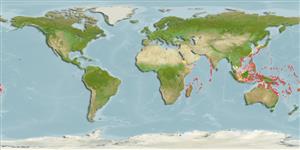Holothuroidea |
Holothuriida |
Holothuriidae
Environment: milieu / climate zone / depth range / distribution range
Ecology
Reef-associated; depth range 0 - 25 m (Ref. 108901), usually 0 - 10 m (Ref. 108901). Tropical
Indo-West Pacific: East Africa to Papua New Guinea and Australia.
Length at first maturity / Size / Weight / Age
Maturity: Lm ? range ? - ? cm Max length : 48.0 cm TL male/unsexed; (Ref. 80470); common length : 35.0 cm TL male/unsexed; (Ref. 80470); max. published weight: 2.8 kg (Ref. 122)
Maximum depth from Ref. 92930. Found on inner reef flats, coastal lagoons, seagrass beds, or sandflats at depths of 0 to 30 m (Ref. 92930). Occurs predominantly from 0 to 10 m (Ref. 98471). During specific time of the day, it buries in sand or muddy-sand (Ref. 92930).
Life cycle and mating behavior
Maturity | Reproduction | Spawning | Eggs | Fecundity | Larvae
Members of the class Holothuroidea are gonochoric and have only one gonad. Spawning and fertilization are both external and some exhibit brooding. Life cycle: Embryos develop into planktotrophic larvae (auricularia) then into doliolaria (barrel-shaped stage) which later metamorphose into juvenile sea cucumbers.
Massin, C., S. Uthicke, S.W. Purcell, F.W.E. Rowe and Y. Samyn 2009 Taxonomy of the heavily exploited Indo-Pacific sandfish complex (Echinodermata: Holothuriidae). Zoological Journal of the Linnean Society 155:40-59. (Ref. 80470)
IUCN Red List Status
(Ref. 130435: Version 2025-1)
CITES status (Ref. 108899)
Not Evaluated
Not Evaluated
Threat to humans
Harmless
Human uses
Fisheries: highly commercial
FAO - Fisheries: landings | FishSource |
Tools
More information
Trophic EcologyFood items (preys)
Diet composition
Food consumption
Predators
Population dynamicsGrowth
Max. ages / sizes
Length-weight rel.
Length-length rel.
Length-frequencies
Mass conversion
Abundance
Life cycleReproductionMaturityFecunditySpawningEggsEgg developmentLarvae PhysiologyOxygen consumption
Human RelatedStamps, coins, misc.
Internet sources
Estimates based on models
Preferred temperature
(Ref.
115969): 24.7 - 29.3, mean 28.2 (based on 1951 cells).
Fishing Vulnerability
Moderate vulnerability (38 of 100).
